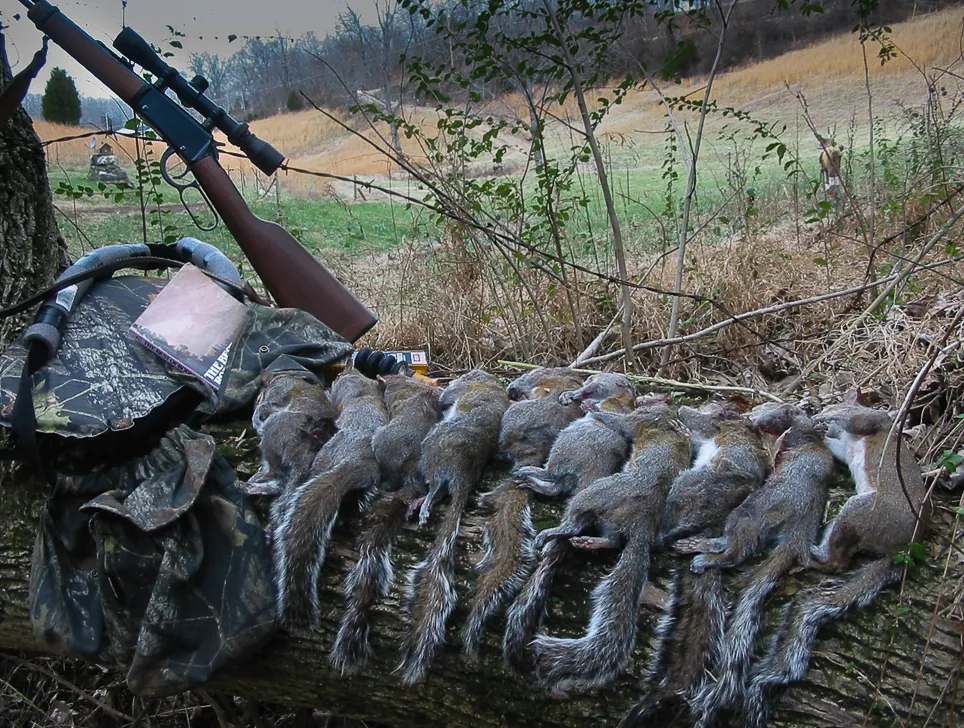Wintertime Squirrel Hunting
Tips & Tricks For Affordable, Accessible, and FUN Squirrel Hunting
Hunting squirrels in the dead of winter can be tough, but very rewarding. Most other seasons are closed and there is a couple of months before good fishing. Squirrels offer a great opportunity to get outside and have some fun and bring home some dinner. Squirrel recipes abound. They offer squirrel hunters many ways to continue the hunt with friends and family while enjoying the harvest with them. Give the squirrel chowder recipe at the end of this article and see what I mean.

A wintertime squirrel hunt offers a great reason to get outside and cure cabin fever. Photo by Ken McBroom
Squirrel hunting is a great way to spend time outdoors during a time when cabin fever can cause us all to become a little unsettled and on edge. Wintertime squirrel hunting can help with that tension and get us through those cold stretches while waiting for spring. Check out these few tips for bagging your limit of squirrels during the harsh winter climate this year.
February in the squirrel woods can be pleasant or it can be brutal. It’s important to dress accordingly, during your late-season squirrel hunt, to ensure a comfortable day afield. Insulated boots that keep your feet warm and dry is important. Be sure your boots are also comfortable for walking. With fewer squirrels this time of year you may have to cover ground to locate active squirrels. The good thing is that all of the walking will help keep you warm. Dressing in layers is the best way to deal with any situation your hunt might throw at you. A daypack or backpack allows you to comfortably carry all your layers, when removed, leaving your hands free for glassing and calling and taking the shot.
Binoculars are important when hunting squirrels in dense woods. Low powered binoculars make it easier to scan through thick cover and locate squirrels that are rummaging on the ground. If you hunt fence rows or open hardwoods, high powered binoculars are great for scanning greater distances in these situations. Spotting a squirrel in these open areas allows you to set up a spot and stalk on an unsuspecting squirrel.
During the late-season leaves are off the trees. The barren branches make it easier for you to spot the squirrels, but it also allows them to spot you. It’s very important to wear camouflage during the late season. Not only is it easier for the squirrels to spot you this time of year, but late-season squirrels that have survived the hunting season thus far and the many hungry predators that stalk the woods, are very alert and leery of intruders. Take this into account and your late-season squirrel hunt will be more successful.
Check out small tracks of woods for late-season squirrels. These areas are usually overlooked and squirrels can be a little easier to locate in these smaller tracts. Fence rows and small patches of woods next to cornfields can be great hunting during cold weather. I’ve found several squirrels in a patch of trees no bigger than an acre way out in the middle of a cornfield. Squirrels will bury corn during the fall and with all that corn surrounding their home, the squirrels in these patches will survive the harshest winters, and most hunters never even check these little patches of woods.
A light snow is great for the late-season squirrel hunter. Squirrels dig in the winter to get to the food they buried earlier in the season. When there’s snow these digs are easy to spot. Locating some of these active digs allows you to focus your efforts on areas with known squirrel activity. If the squirrels are obviously inactive then move on. Make a mental note of where these digs are located so you can return later when the squirrels may be more active.
If the wind is howling during your hunt look for creek bottoms and other areas where the wind is blocked. Squirrels will be more active in calmer areas. These areas can even draw squirrels in from areas where the wind is blowing. When this happens, your hunt can go from bad to excellent. When squirrels travel outside their territory, to either search for food or escape the elements, fights will break out between the invading squirrels and that area’s resident squirrels. When this happens, the squirrels are easy to locate as they chase and voice their displeasure with the intruders.
When stalking through your hunting area be sure to focus on the ground as you move slowly through the woods. Squirrels have great hearing and eyesight and will pick you off from a great distance. Avoid stepping on sticks or making any quick movements. Move slowly from one point of cover to another. Once at the next point of cover, scan the area for movement with your eyes before using the binoculars to search further out. Squirrels are hard to see when they’re digging and a slow methodical search is important. If you spook a squirrel, this time of year, you might never know it’s there. Those loud obnoxious squirrels you see in the early season are likely in a freezer or stew pot and the squirrels that remain will usually just hop on the side of the tree opposite you and quietly move around as you approach. This is especially true on public land, be stealthy.
Calling squirrels during the winter can be a challenge. It depends on how many hunters have been in the area and how many of those hunters used calls. During the late season, calls can trigger two responses, a territorial response, and a feeding response. Two of the most commonly used calls is the bark and the cutting call. A squirrel barks when voicing its presence and when danger enters the area, like a hawk or a hunter. This is to alert other squirrels. Cutting is when the squirrel is eating nuts and grinds its teeth on the shell cutting it open to get at the meat. Either call can locate squirrels during the cold winter months. The cutting call will get the squirrels’ curiosity and it will investigate to see who is eating nuts in its area.
The best way I’ve found to locate and harvest a limit of cold weather squirrels is by listening closely to the woods. Calm winter days are the best. You can hear surprisingly well even on windy days provided you hunt those protected areas as mentioned above. Late winter means very dry leaves. This is where squirrels bury their winter cache of nuts. Listening to the woods can help you locate squirrels as they dig. You can hear this digging from quite a distance unless it’s raining. It isn’t always easy to pinpoint exactly where the squirrel is, but once you do you can start a silent stalk. Go slow and watch for other squirrels as you go. You know from the rustling leaves where the squirrel should be. Glass as you go because the sooner you locate its location the better. You can move a little faster when the squirrel has its head buried in the leaves. Be cautious, late-season squirrels are on the alert and will snap their head up quickly to survey their surroundings. When they do this they can spot you as you’re moving in.
If you have cabin fever and want to get in the woods try squirrel hunting this winter. It’s a great time for friends and family and can provide everyone with a great dinner to boot. Late winter squirrel hunting is also a great time to scout for deer. Scrapes and rubs are still visible and if you’re a deer hunter it can help you locate great stand locations for the coming season.
Squirrel Chowder
2 whole squirrels
1 pound venison, cubed
1 cup sliced celery
1 can whole kernel corn
2 onions, sliced
1 can tomato juice
1 can green beans
4 potatoes, cubed
2 carrots, sliced
1 can peas
Salt, pepper, red pepper to taste
Combine meat, celery, corn, onions, salt and pepper. Cover with water and cook until meat is tender then remove squirrel meat from bones. Add remaining ingredients and cook until tender (Slow cooker recommended).
This great recipe found on the New Jersey Division of Wildlife website.
About the Author
Ken McBroom is a freelance writer and photographer based in Kentucky. For more squirrel hunting information and much more outdoors visit www.ramblingangler.com. Or email [email protected]






